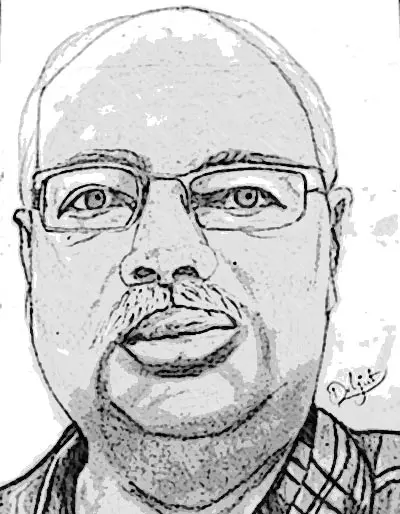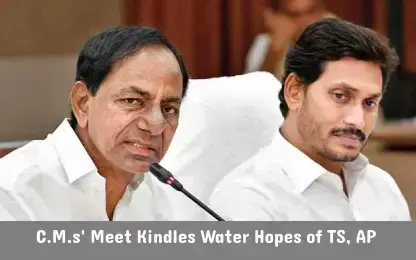Live
- Siddaramaiah govt snatching away food security of poor, says ex-CM Bommai
- AAP releases first list of 11 candidates for Delhi Assembly elections
- District Collector Adarsh Surabhi wants disabled people to be inspired by the perseverance and hard work of the disabled
- Jupally, Seethakka inaugurate Third Island in Laknavaram Lake
- Chittoor police bust interstate robbery Gang
- Expedite Vizag-Chennai Industrial Corridor works says Collector S Venkateswar
- Chandrababu speaks on High Court Bench in Kurnool, says ready to develop state
- 3-day training to visually challenged students concludes
- iPhone SE 4: Launch with New Features Expected in March 2024
- Sri Vishnu students to take part in South Zone Games
Just In
C.M.s' Meet Kindles Water Hopes of TS, AP


A good beginning seems to have been made between the two Telugu States to resolve the interstate disputes that had arisen out of bifurcation of the...
A good beginning seems to have been made between the two Telugu States to resolve the interstate disputes that had arisen out of bifurcation of the State in 2014. If both the States would continue their relationship with such bonhomie, there is every possibility that a qualitative change in relations would be a certainty.
Both the Chief Ministers have chosen the most urgent and important issue of ensuring supply of water to every nook and corner of both the States so that agriculture, industry and drinking water problems are addressed effectively. This is very important as availability of water is going down in Krishna River.
It may further get reduced in the years to come. If they can arrive at a workable solution which would also be acceptable to majority of the stakeholders in both the States, then it can help the Rayalaseema region, Nellore and Prakasasm districts in AP and Palamuru and United Nalgonda districts in Telangana.
In fact, India is among those countries which face acute water crisis. We are seeing how Chennai and Bangalore are facing water crisis. This year, the monsoon got delayed and though it arrived, it was just a bucketful of water and nothing more.
As cities and towns grow, the pressure on urban water resources is expected to increase - reports estimates that demand will be twice as much as available supply by 2030. Water scarcity would also account for a 6% loss in India's gross domestic product (GDP).
Indian cities and towns regularly run out water in the summer because they lack the infrastructure to deliver piped water to every home. Rural areas are also badly affected by a lack of access to clean water. They cannot rely on groundwater due to erratic rains and the fact that the groundwater is increasingly used for farming when monsoon rains are delayed or insufficient.
A Niti Aayog report released last year predicts Day Zero for 21 Indian cities by next year. Day Zero refers to the day when a place is likely to have no drinking water of its own. According to the Niti Aayog's Composite Water Management Index (CWMI), Bengaluru, Chennai, Delhi and Hyderabad are among the most susceptible.
India has several rivers and used to have good monsoon. But the big question now is why are we facing water crisis? We are running short of water over the ground and are now facing deep trouble as we have overexploited groundwater. Reports indicate that we have used more groundwater than China and US. According to a report by the standing committee on water resources, groundwater forms the largest share of India's agriculture and drinking water supply.
About 89 per cent of groundwater extracted in India is used for irrigation, making it the highest category user in the country. About 50 per cent of urban water requirement and 85 per cent of rural domestic water need are fulfilled by groundwater. This the Central Ground Water Board said had resulted in steep downfall in groundwater levels.
Despite promises by all political parties and various claims made by them, the fact remains that majority of the rural households do not have piped water access. Reports also indicate that where water is available, it is not properly distributed. As per the norms prescribed by the World Health Organisation, each individual requires 25 litres of water per day to meet basic hygiene and food needs.
India needs a maximum of 3,000 billion cubic metres of water a year while it receives 4,000 billion cubic metres of rain. But according to Central Water Commission, the problem is India captures only eight per cent of its annual rainfall - among the lowest in the world.
Another major problem in India is that we tend to waste water when it is available without realising its importance and need to preserve it. We have also not developed proper system to recycle used water and almost 75 percent of the water used by households are drained out as waste which has resulted in pollution of land and other water bodies.
Many teams and even politicians have visited Israel which is a desert country, wrote articles and gave lectures on Israel technology to conserve water but did nothing in practice to implement such modules here. In Israel 94 percent of used water is treated and supplied to households and is also used for irrigation purposes.
Unfortunately, in India, we have even failed to promote water conservation measures like rain harvesting pits. Some have created rain harvesting pits because the municipal authorities insisted initially but later did nothing to see that the pits are active. Even the pits in government buildings are used for dumping garbage.
That is our level of awareness on water conservation and it indicates how serious the governments are in enforcing the laws it makes. In fact, the concerned civic authorities have also failed in plugging the leakage of piped water. It is estimated that about 40 percent of piped water in urban areas goes waste.

© 2024 Hyderabad Media House Limited/The Hans India. All rights reserved. Powered by hocalwire.com






